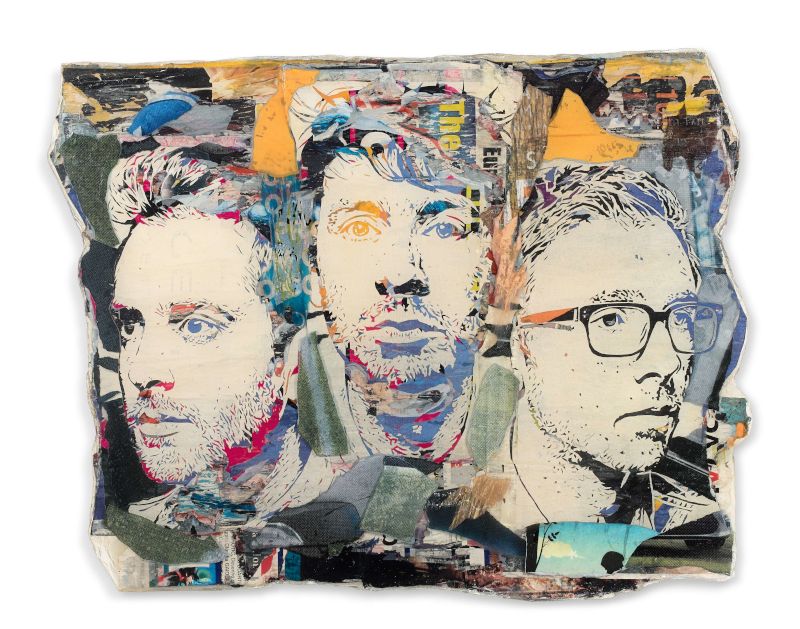A number of well-known artists are getting into NFTs, including Damien Hirst, Takashi Murakami and Vhils.
[11/03/2022]A year ago, NFTs took the art market by storm with the major auction houses substantially boosting the phenomenon: first Christie’s, then Sotheby’s and Phillips. A number of art galleries were quickly seduced, some, like the Pace Gallery, developing their own platforms. Most of them, however, are still preferring to wait, even when their artists are already devising major digital projects, with some artists having independently pushed ahead with their own digital adventures.

Vhils, Delphic (2012). Torn poster, tearing, epoxy resin. Sold for $39,300 on 5 May 2019 ©Artcurial
thierry Ehrmann, CEO and Founder of Artmarket.com and its Artprice department: “There is a strong temptation for artists to test the new NFT market driven by dizzying growth and offering all kinds of openings, in fashion, music, video games, etc. However, this universe is governed by its own codes: to succeed in it, you need to be able to build a real digital project, and you need to bring together a community of collectors, write smart contracts, and master the whole process of ‘drops’, etc.”.
Many of these logistical tasks would normally be managed by a gallery, but so far they have been taken care of by the artists themselves and their teams, with varying degrees of success.
Big names in Contemporary Art
Adept at collaborating with big brands, the Japanese artist Takashi MURAKAMI has worked over the past few months with the RTFKT studio, recently acquired by the company Nike: “I felt that I could learn a lot about the metaverse from these young people”. At the end of March 2021, Murakami had posted 108 flowers on the OpenSea platform, but took them down a few days later. With his new collaboration with RTFKT and having been able to rework his works as well as his smart contracts, he is in the process of making a new drop of his Murakami.Flowers.
Urs FISCHER also released a collection of NFTs in the spring of 2021. Interviewed by the Wall Street Journal, his gallery owner Larry Gagosian said he wanted to take the time to explore the issues of NFT technology before going ahead with it. Meanwhile, Damien HIRST has also launched a collection of NFTs, called The Currency. Following in the footsteps of Andy WARHOL (whose eponymous Foundation sold five of his digital creations via Christie’s in the form of NFTs in May 2021), Damien Hirst has created 10,000 works on the border between unique creations and interchangeable investments, thus questioning the non-fungible aspect of NFTs: “when art changes and becomes a currency, and when currency becomes art”.
Street artists already ahead of the game…
Accustomed to working with, but also without, the assistance of their galleries, street artists are a little better equipped to navigate the NFT jungle. Most of them adopted pseudonyms and began working in the shadows, often during the night, while their works were only discovered at dawn, before traveling around the world on social networks. This modus operandi has much in common with NFT drops.
The Portuguese artist VHILS, famous for his mural works – created by removing material with a chisel or with explosives – has clearly demonstrated his mastery of digital codes. Very active on Twitter, Discord and Instagram, he already has around ten collections on the platform Nifty Gateway. His ephemeral creations are therefore given an alternative way of existing in the digital space. It is now possible to acquire videos of his explosions and of the resulting “detritus”.
Echoing his artistic practices, Vhils is also using one of the options associated with NFTs, known as “burning”, to erase NFTs from their Blockchain contracts. “Through burning, holders of NFTs from my previous drops can trade them for new and rarer ones. This process empowers supporters of my work to influence which pieces live and which ones perish.
Two other street artists from the Danysz gallery, Faile and Futura 2000, have also minted tokens on the Nifty Gateway platform, as indeed have D*Face, Mr Doodle and even Kenny Scharf.
The innovators
Daniel ARSHAM was very quick to appreciate the possibilities of extending his universe into the Metaverse via a collaboration with the SixN.Five studio. In May 2021, they jointly launched an Open Edition titled Eroding and Reforming Bust of Rome (One Year): 671 NFTs were minted for an introductory price of $1,500, while the lowest price for one of these is currently $4,900. Represented by the Perrotin gallery, Daniel Arsham has already produced six other series of NFTs in more or less rare editions, from the unique work titled Eroding and Reforming Venus of Arles (72.6 Years) to an edition of 200 copies, called Eroding and Reforming 356.
Among the proposals by Contemporary artists that best exploit the codes of the NFT market, one of the most remarkable is that of the Rocket Factory. Artist Tom SACHS, represented by Thaddaeus Ropac Gallery, has invented 1,000 rockets consisting of three parts (nose cone, body and tail assembly) which can be purchased separately and recombined to create a complete rocket. This can then “take off”: the three parts are erased and replaced by a new rocket, while a ‘real’ copy is made by Tom Sachs and sent into the air: “The Completed Rocket NFT, its Physical Rocket twin (if recovered), and the video documenting the launch form a Holy Trinity”.
Despite the issues surrounding the security of collections in e-wallets and the origin of NFTs on platforms (starting with OpenSea), a growing number of Contemporary artists are seeing a tremendous opportunity in NFT technology to bring to life whole chapters of their work which could not be traded before, and to invent new creations in the Metaverse.




 0
0
